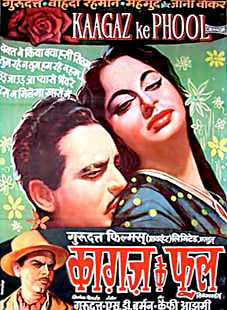Kaagaz Ke Phool (1959) is a masterpiece by Guru Dutt. Ironically it was a box office disaster upon its release but years later Kaagaz Ke Phool was hailed as one of the classic films in Hindi. The film starred Guru Dutt and Waheeda Rehman as the lead pair. The rest of the cast includes Johnny Walker, Veena, Naaz, Minoo Mumtaz, Mahesh Kaul, Pratima Devi, Niloufer, Mohan Choti, Uma Devi and others. S. D. Burman composed the music and the lyrics were provided by Kaifi Azmi. Kaagaz Ke Phool is also considered a semi autobiographical film of Guru Dutt. It was also the last film in which Guru Dutt donned the cap of a director.
 Guru Dutt was motivated by the success of Pyaasa (1957) and went on to make another challenging film, Kaagaz Ke Phool. The plot revolves around Suresh Sinha (Guru Dutt), a famous film director. His family life is messed up as his wife Bina (Veena) and her affluent family looks contemptuously on the job of filmmaking. They think that there is no social status in such a profession. Suresh is also separated from his daughter Pammi (Naaz) when the family sends her away to a boarding school.
Guru Dutt was motivated by the success of Pyaasa (1957) and went on to make another challenging film, Kaagaz Ke Phool. The plot revolves around Suresh Sinha (Guru Dutt), a famous film director. His family life is messed up as his wife Bina (Veena) and her affluent family looks contemptuously on the job of filmmaking. They think that there is no social status in such a profession. Suresh is also separated from his daughter Pammi (Naaz) when the family sends her away to a boarding school.
Suresh Sinha comes across Shanti (Waheeda Rehman) on a rainy night and gives her his coat. To return the same she visits his film studio and unawares walks in front of the camera. Being a director Suresh sees the potential in her and chooses her as the Paro in his film, Devdas. Shanti soon becomes a star. Behind the camera both Shanti and Suresh come close to each other. It is their loneliness that brings them close. Soon the gossip columns start writing about them. Suresh`s daughter has to face teasing in school for her father`s alleged affair. She confronts Shanti and asks her to leave so that her parents` marriage is not ruined. Shanti is heartbroken but she leaves abandoning her career and taking up a job of a schoolteacher. With Shanti gone Suresh turns to alcohol and his career, too, is totally ruined. It ultimately leads to a downhill journey that results in his losing everything: love, companionship, mental peace, money, fame and ultimately his life.
On the other hand Shanti is compelled to return to the world of cinema business as she had signed a contract with the studio. Fate gives him one chance to put things straight with the return of Shanti. However she fails to help him as Suresh has gone too far to return. The very last scene of Kaagaz Ke Phool Suresh is seen in the empty film studio. He reminisces his good old days and breaths his last breath in his director`s chair. The audience probably could not come to terms with such a tragedy. Kaagaz Ke Phool also dealt with the nuances of filmmaking. The ways in which a film is made is thoroughly shown in Kaagaz Ke Phool.
The theme of Kaagaz Ke Phool was much ahead of its time. The audiences then failed to recognise the masterpiece that Guru Dutt had created. The underlying tones in the film were completely missed by the Indian audience who were used to simpler plots. Kaagaz ke Phool is in fact listed in top ten classic Hindi movies. Guru Dutt`s influence on Indian movies continues even today.
Many consider Kaagaz ke Phool to be a semi-autobiographical film of Guru Dutt. The similarities can hardly be missed. While some feel that the film has resemblance to his personal life dealing with Guru Dutt`s marriage with Geeta Dutt, his liking for Waheeda Rehman and the subsequent problems that arose out of it. On the other hand some critics opine that the subject in Kaagaz ke Phool is inspired from the tragic life of Gyan Mukherjee. He was the popular director of 1940s and Guru Dutt has worked with him in Qismet (1941). But after this Gyan Mukherjee`s films met with failure and he was promptly forgotten. Guru Dutt was deeply moved by his life. In fact Pyaasa was dedicated to Gyan Mukherjee.
Although Kaagaz ke Phool bombed at the box office it bagged two awards at the Filmfare Awards:
Best Cinematographer Award - V.K. Murthy
Best Art Director - M.R. Achrekar






